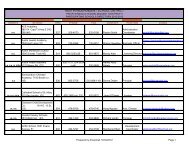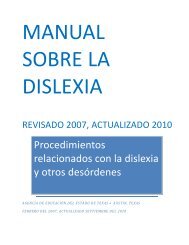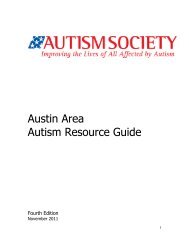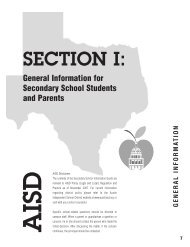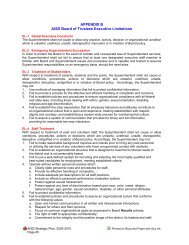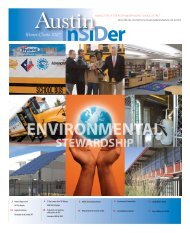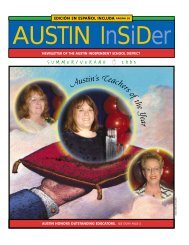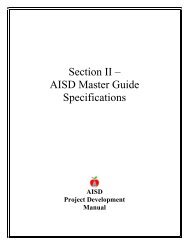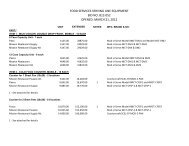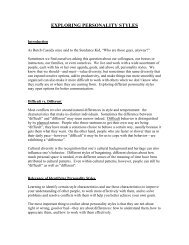1 Module Five—Critical Thinking Introduction Critical ... - Austin ISD
1 Module Five—Critical Thinking Introduction Critical ... - Austin ISD
1 Module Five—Critical Thinking Introduction Critical ... - Austin ISD
Create successful ePaper yourself
Turn your PDF publications into a flip-book with our unique Google optimized e-Paper software.
<strong>Introduction</strong><br />
<strong>Module</strong> <strong>Five—<strong>Critical</strong></strong> <strong>Thinking</strong><br />
<strong>Critical</strong> thinking is often perceived as a difficult skill separate from the thinking process as a<br />
whole. In fact, it is the essence of thinking. It is not enough to know what to think; one must<br />
also know how and why to think. <strong>Thinking</strong> consists of whatever goes on in your head. It is the<br />
extraordinary process we use every waking moment to make sense of our world and our lives.<br />
Therefore we need a system for deciding rationally what to or what not to believe. Tutors must<br />
be aware of the importance of helping students develop critical thinking skills if students are to<br />
become independent learners. Students must be taught not just content areas but effective<br />
problem solving strategies as well.<br />
Definition<br />
The American Philosophical Association defines critical thinking as: “. . .the process of<br />
purposeful, self-regulatory judgment. This process gives reasoned consideration to evidence,<br />
contexts, conceptualizations, methods, and criteria.”<br />
Another explanation defines it thusly: “<strong>Critical</strong> thinking is the art of thinking about your<br />
thinking while you are thinking if order to make your thinking better—more clear, more<br />
accurate, more defensible.”<br />
The purpose of critical thinking is to achieve understanding, evaluate viewpoints, and solve<br />
problems. Since all three areas involve the asking of questions, we can say that critical thinking<br />
is the “questioning or inquiry we engage in when we seek to understand, evaluate, or resolve.”<br />
Uses of <strong>Critical</strong> <strong>Thinking</strong><br />
Dave Ellis, author of Becoming a Master Student, lists the following uses for critical thinking:<br />
1. Underlies reading, writing, speaking, and listening . . . the basic elements of<br />
communication.<br />
2. Plays an important part in social change . . . institutions in any society—courts,<br />
governments, schools, businesses—are products of a certain way of thinking.<br />
3. Helps uncover bias and prejudice.<br />
4. Provides a path to freedom from half-truths and deceptions.<br />
5. Is the willingness to change one point of view as we continue to examine and re-examine<br />
ideas that may seem obvious; such thinking takes time and the willingness to say three<br />
subversive words: I don’t know.<br />
<strong>Critical</strong> thinkers distinguish between fact and opinion; ask questions; make detailed<br />
observations; uncover assumptions and define their terms; and make assertions based on sound<br />
logic and solid evidence.<br />
1
Attributes of <strong>Critical</strong> Thinkers<br />
1. Ask pertinent questions<br />
2. Assess statements and arguments<br />
3. Admit a lack of understanding or information<br />
4. Have a sense of curiosity<br />
5. Are interested in finding new solutions<br />
6. Are able to clearly define a set of criteria for analyzing ideas<br />
7. Are willing to examine beliefs, assumptions, and opinions and weigh them against facts<br />
8. Listen carefully to others and give feedback<br />
9. See that critical thinking is a lifelong process of self-assessment<br />
10. Suspend judgments until all facts have been gathered and considered<br />
11. Look for evidence to support assumptions and beliefs<br />
12. Adjust opinions when new facts are found<br />
13. Look for proof<br />
14. Examine problems closely<br />
15. Are able to reject information that is incorrect or irrelevant<br />
16. Take charge of their own thinking<br />
Effective <strong>Critical</strong> Thinkers acknowledge that:<br />
1. THINKING IS AN ACTIVE PROCESS. When we try to solve a problem, reach a<br />
goal, understand information, or make sense of someone, we are actively using our minds<br />
to figure out the situation.<br />
2. THINKING IS DIRECTED TOWARD A PURPOSE. The purpose may be to solve a<br />
problem, reach a goal, understand information, or make sense of someone.<br />
3. THINKING IS AN ORGANIZED PROCESS. <strong>Thinking</strong> effectively has an order or<br />
organization. There are certain steps to take to solve that problem, reach that goal,<br />
understand that information, or make sense of someone.<br />
4. THINKING CAN BE DEVELOPED AND IMPROVED. During our lifetime we<br />
develop thinking through use, by becoming aware of the thinking process, and by<br />
practicing. <strong>Thinking</strong> can be developed and improved through guidance and practice.<br />
Ineffective <strong>Critical</strong> Thinkers’ Habits Tutors Can Help By<br />
1. Impulsive, jump to conclusions. 1. Remember “wait time”;<br />
give them time to think of<br />
the answer.<br />
2. Give up quickly. 2. Encourage student to stick<br />
it out, to persist with tasks.<br />
3. Inflexible in approaching thinking tasks. 3. Recognize each student<br />
will have his/her own<br />
concepts; try visualization.<br />
2
4. Use imprecise language. 4. Speak clearly and precisely<br />
to clarify what they mean<br />
as well as showing tutees<br />
the importance of exact<br />
language and details.<br />
5. Plunge into a thinking task 5. Use organizational tips<br />
without planning what to do. such as charts or lists.<br />
6. Fail to check work for accuracy. 6. Give examples why there<br />
is a never-ending need for<br />
accuracy, such as the<br />
surgeon who is not sure<br />
where to cut, or the disaster<br />
of the Challenger shuttle.<br />
7. Are reluctant to secure as much 7. Provide several examples<br />
data as possible. or make students try new<br />
ways of solving problems.<br />
8. Skip steps; often are unable to 8. Encourage tutees to make<br />
backtrack to find mistakes. lists, to verbalize steps, to<br />
write steps out of order<br />
then put back in sequence.<br />
9. Are unable to engage in a logical 9. Break concepts down into<br />
line of reasoning. smaller bits of information.<br />
10. Are often incapable of launching 10.Point out the key objective<br />
a thinking task. then list main steps to get<br />
the job done; “just do it”!<br />
CRITICAL READING<br />
Definition<br />
Reading is the key component of much learning. It is crucial that students not only be critical<br />
thinkers, but also critical readers.<br />
<strong>Critical</strong> reading is (1) the process of making judgments in reading: evaluating relevance and<br />
adequacy of what is read, and (2) an act of reading in which a questioning attitude, logical<br />
analysis, and inference are used to judge the worth of what is read according to an established<br />
standard. . .Among the identified skills of critical reading involved in making judgments are<br />
those having to do with the author’s intent or purpose; with the accuracy, logic, reliability and<br />
authenticity of writing; and with the literary forms, components, and devices identified through<br />
literary analysis.<br />
3
<strong>Critical</strong> Readers are:<br />
1. Willing to spend time reflecting on the ideas presented in their reading assignments.<br />
2. Able to evaluate and solve problems while reading rather than merely compile a set of<br />
facts to be memorized.<br />
3. Logical thinkers.<br />
4. Diligent in seeking out the truth.<br />
5. Eager to express their thoughts on a topic.<br />
6. Seekers of alternative views on a topic.<br />
7. Open to new ideas that may not necessarily agree with their previous thought on a topic.<br />
8. Able to base their judgments on ideas and evidence.<br />
9. Able to recognize errors in thought and persuasion as well as to recognize good<br />
arguments.<br />
10. Willing to take a critical stance on an issue.<br />
11. Able to ask penetrating and thought-provoking questions to evaluate ideas.<br />
12. In touch with their personal thoughts and ideas about a topic.<br />
13. Willing to reassess their views when new or discordant evidence is introduced and<br />
evaluated.<br />
14. Able to identify arguments and issues.<br />
15. Able to see connections between topics and use knowledge from other disciplines to<br />
enhance their reading and learning experiences.<br />
TIPS for Tutors to Enhance <strong>Critical</strong> <strong>Thinking</strong><br />
1. Don’t automatically answer questions the tutee has. Instead, whenever possible, turn the<br />
question back to the student. Ask questions such as: What do you think? What ideas do<br />
you have about that? What has been your experience?<br />
2. When presenting new information, rather than simply telling the tutee, try asking<br />
questions. Develop a repertoire of generative questions, such as: What do you already<br />
know about that? What do you mean by that? Is there another way to view this? Might<br />
anyone else see it differently?<br />
3. Encourage specific responses and reasons for students’ viewpoints with questions such<br />
as: Can you be more specific? Why do you think that? What exactly do you mean by<br />
that?<br />
4. Encourage students to see the problem, situation, or concept from a different viewpoint.<br />
If working on a math problem, for example, ask the tutee if he or she can think of another<br />
way to solve the problem. What would happen if we changed the order in which we<br />
solved the problem? When working on a history issue, ask How might this issue have<br />
looked to the opposing side?<br />
5. Help students talk through problems. Encourage them to think out loud and model this<br />
yourself by vocalizing your own thought processes, trying to implement specific<br />
reasoning skills as you do so. This fosters better thinking in students by enabling them to<br />
evaluate their own process and serves as a means to understand the student’s thought<br />
process. It also enables you to discover where errors in thought occur. Some questions<br />
4
to ask might include: What would you do first? What would you do next? Is there<br />
another way to do this? How would you change this? What conclusions can you draw?<br />
6. Encourage students to begin generating questions of their own. Show them how to build<br />
simple questions from the table of contents, chapter headings, main idea statements, and<br />
summaries by using the six reportorial questions—who, what, when, where, why, and<br />
how.<br />
7. Have students analyze their own work, looking for patterns in their thinking and in their<br />
mistakes. You can ask: Did you follow all the directions? Are there steps you omitted?<br />
Are there vocabulary terms you need to clarify to avoid confusion?<br />
8. Pay attention to where tutees are in the process. As long as they are able to respond<br />
effectively to your probing, continue asking leading, open-ended questions. If they<br />
become frustrated or seem lost, you will want to provide more guidance. If basing<br />
questions on Bloom’s Taxonomy, you might need to drop back to a lower level of<br />
questioning until the tutee becomes comfortable with information at that level, then<br />
progressing to higher levels. To use an example from history, if a student has trouble<br />
answering a questions such as Can you justify the economical implications of the South’s<br />
loss of slave labor? (evaluation) try to rephrase the question to Can you name three ways<br />
the loss of slave labor would impact the economy of the South? (analysis)<br />
9. Lengthen your response time. Remember that it takes time to think. Remember, too, that<br />
tutees may become anxious, particularly if they feel they are put on the spot, are<br />
unprepared, or have low self-esteem; this sometimes causes the mind to go blank. Be<br />
sure they feel comfortable and unhurried.<br />
10. Remember that your tutees probably know more than you—or they think that they do.<br />
Your most important tutoring goal should be empowering tutees, enabling them to trust<br />
their own abilities. Remember that thinking—real thinking—is hard work. Be gentle<br />
with those you are tutoring and give lots of positive support, praise, encouragement, and<br />
reinforcement. An added benefit is the increase in your own skills as a critical thinker.<br />
The more you help others learn, the more you will learn.<br />
Much of this information has been taken from these sources:<br />
“An <strong>Introduction</strong> to <strong>Critical</strong> <strong>Thinking</strong>”, by Elaine Batenhorst, University of Nebraska at<br />
Kearney, in Tutor Training Handbook, edited by Tom Gier and Karan Hancock, CRLA, 1996.<br />
“<strong>Critical</strong> <strong>Thinking</strong> Across the Curriculum Project”, Longview Community College, Lee’s<br />
Summit, Missouri, 1997.<br />
“How Tutors Can Help Tutees Improve Their <strong>Critical</strong> <strong>Thinking</strong>”, by Suzanne Forster, University<br />
of Alaska at Anchorage, in Tutor Training Handbook, edited by Tom Gier and Karan Hancock,<br />
CRLA, 1996.<br />
5
Evaluation<br />
<strong>Module</strong> <strong>Five—<strong>Critical</strong></strong> <strong>Thinking</strong><br />
1. What is your definition of critical thinking?<br />
2. List one way students may use critical thinking.<br />
3. Name three attributes of critical thinkers.<br />
6
4. Describe two habits of ineffective thinkers and the ways tutors might help with these<br />
problems.<br />
5. What are three characteristics of critical readers?<br />
6. Give two additional tips a tutor could use to help a tutee develop critical thinking.<br />
7



